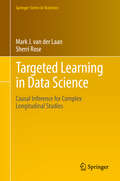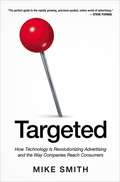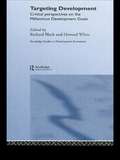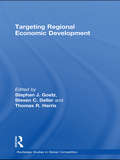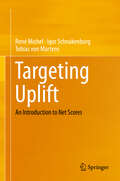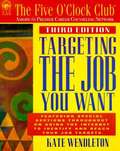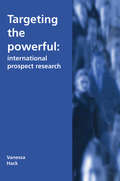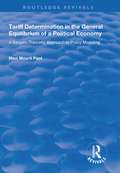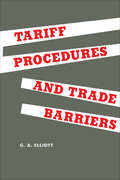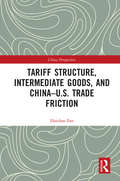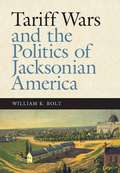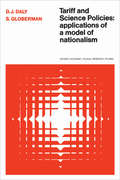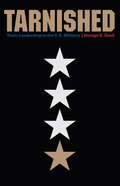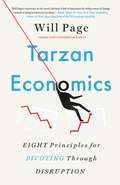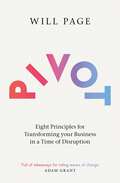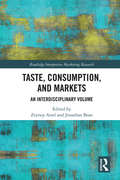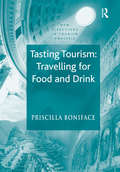- Table View
- List View
Targeted Learning in Data Science: Causal Inference For Complex Longitudinal Studies (Springer Series in Statistics)
by Mark J. van der Laan Sherri RoseThis textbook for graduate students in statistics, data science, and public health deals with the practical challenges that come with big, complex, and dynamic data. It presents a scientific roadmap to translate real-world data science applications into formal statistical estimation problems by using the general template of targeted maximum likelihood estimators. These targeted machine learning algorithms estimate quantities of interest while still providing valid inference. Targeted learning methods within data science area critical component for solving scientific problems in the modern age. The techniques can answer complex questions including optimal rules for assigning treatment based on longitudinal data with time-dependent confounding, as well as other estimands in dependent data structures, such as networks. Included in Targeted Learning in Data Science are demonstrations with soft ware packages and real data sets that present a case that targeted learning is crucial for the next generation of statisticians and data scientists. Th is book is a sequel to the first textbook on machine learning for causal inference, Targeted Learning, published in 2011.Mark van der Laan, PhD, is Jiann-Ping Hsu/Karl E. Peace Professor of Biostatistics and Statistics at UC Berkeley. His research interests include statistical methods in genomics, survival analysis, censored data, machine learning, semiparametric models, causal inference, and targeted learning. Dr. van der Laan received the 2004 Mortimer Spiegelman Award, the 2005 Van Dantzig Award, the 2005 COPSS Snedecor Award, the 2005 COPSS Presidential Award, and has graduated over 40 PhD students in biostatistics and statistics.Sherri Rose, PhD, is Associate Professor of Health Care Policy (Biostatistics) at Harvard Medical School. Her work is centered on developing and integrating innovative statistical approaches to advance human health. Dr. Rose’s methodological research focuses on nonparametric machine learning for causal inference and prediction. She co-leads the Health Policy Data Science Lab and currently serves as an associate editor for the Journal of the American Statistical Association and Biostatistics.
Targeted: How Technology Is Revolutionizing Advertising and the Way Companies Reach Consumers
by Mike SmithFar from the catchy television spots and sleek magazine spreads are the comparatively modest ads that pop up on websites and in Internet searches. But don't be fooled--online advertising is exploding. Growing at a compound annual rate near 20%, it is now the second-largest advertising channel in the United States. Part history, part guidebook, part prediction for the future, Targeted tells the story of the companies, individuals, and innovations driving this revolution. It takes readers behind the scenes--examining the growth of digital advertising, its enormous potential, and the technologies that are changing the game forever. Leading the way is real-time bidding, which offers advertisers unprecedented precision in targeting ads and measuring their effectiveness. From keyword micro-markets and ad serving systems to aggregated virtual audiences and new business models, Targeted is sweeping in scope and stripped of technical complexity. It is an essential resource for anyone interested in finding and connecting with customers in the vast and shifting Internet universe.
Targeting Development: Critical Perspectives on the Millennium Development Goals (Routledge Studies In Development Economics Ser. #36)
by Howard White Richard BlackThe Millennium Development Goals accepted by the UN in 2000 are, along with the targets set by the OECD in 1996 the subject of this expertly written book. Is development achievable in the time frames given? How useful were the goals in the first place? How far have we come in solving the aching problems of the developing world? These questions and
Targeting Myth Markets: The First Step in Developing a Cultural Branding Strategy
by Douglas B. HoltIdentity brands are different from those competing in product markets. They participate in myth markets, competing and collaborating with other cultural products like films, music, television, sports, and books. The first step of your cultural branding strategy, therefore, must be identifying and targeting the most appropriate myth market.
Targeting Regional Economic Development (Routledge Studies in Global Competition)
by Steven C. Deller Stephan J. Goetz Thomas R. HarrisTargeting regional economic development (TRED) has a long and rich tradition among academic economists and in the world of economic development practitioners. This book builds on a series of workshops and papers organized by The Northeast Regional Center for Rural Development (NERCRD) at the Pennsylvania State University and the Rural Policy Research Centre (RUPRI) at the University of Missouri. Through the coordinated efforts of NERCRD and RUPRI, a network of university based researchers and Extension education specialists was developed and provides the foundation of this new edited volume. For the first time in a single book, Goetz, Deller and Harris present an innovative approach through a collection of chapters discussing industry targeting and the relevance of TRED as an important analytical tool for practical targeting purposes. The papers present issues surrounding community economic development, clusters in industry and rural communities and the role of agglomeration economies. The book provides the reader with insights into not only the theoretical foundations of targeting as well as empirical methods, but also approaches for using the community-level analysis to affect policy directions.
Targeting Uplift: An Introduction to Net Scores
by René Michel Igor Schnakenburg Tobias von MartensThis book explores all relevant aspects of net scoring, also known as uplift modeling: a data mining approach used to analyze and predict the effects of a given treatment on a desired target variable for an individual observation. After discussing modern net score modeling methods, data preparation, and the assessment of uplift models, the book investigates software implementations and real-world scenarios. Focusing on the application of theoretical results and on practical issues of uplift modeling, it also includes a dedicated chapter on software solutions in SAS, R, Spectrum Miner, and KNIME, which compares the respective tools. This book also presents the applications of net scoring in various contexts, e.g. medical treatment, with a special emphasis on direct marketing and corresponding business cases. The target audience primarily includes data scientists, especially researchers and practitioners in predictive modeling and scoring, mainly, but not exclusively, in the marketing context.
Targeting the Job You Want (Five O'Clock Club Series)
by Kate WendletonThe best book on the market to help you figure out who you are, what you enjoy doing, and what you want to do with your life. Landing the job of your dreams means you need to have a dream to begin with. TARGETING THE JOB YOU WANT helps you Identify that dream... make it specific... and figure out step by step how you can achieve it.
Targeting the Powerful: International Prospect Research
by Vanessa HackFirst Published in 2000. Routledge is an imprint of Taylor & Francis, an informa company.
Targets, Resource Allocation, Initiatives, and Budgets
by Robert S. Kaplan David P. NortonManagers should use their Balanced Scorecard to implement an integrated strategy and budgeting process. The business must align its financial and physical resources to the strategy. This chapter introduces a four-step process for using the Balanced Scorecard to integrate long-range strategic planning and operational budgeting processes, including instruction on the importance of setting stretch targets and identifying critical cross-business initiatives. This chapter was originally published as chapter 10 of "The Balanced Scorecard: Translating Strategy into Action."
Targets: Picking Your Spots for Analytics--How to Apply Analytics Where They Will Yield the Greatest Results
by Thomas H. Davenport Jeanne G. Harris Robert MorisonEvery business can benefit from becoming more analytical across the board--in how it understands its customers, performs its operations, and makes decisions. But even the most analytically oriented company needs to target its analytical efforts where they will do the most good, because resources--especially talent--are always constrained. In this chapter, the authors of the game-changing book Competing on Analytics guide you through choosing your targeted areas for analytics. They show you how to analyze both your organization's strategic plan as well as industry trends, set appropriate goals, and prioritize your best targets. The chapter includes tools and techniques that will help you to thoroughly and purposefully weigh your opportunities and move your organization toward becoming a more analytical competitor. This chapter was originally published as Chapter 5 of Analytics at Work: Smarter Decisions, Better Results.
Tariff Determination in the General Equilibrium of a Political Economy: A Bargain-theoretic Approach to Policy Modelling (Routledge Revivals)
by Hom Moorti PantFirst published in 1997, this volume builds an economic model in which a model of the policy-formation process was grafted onto an economic model of the traditional kind. Politics are not made in a vacuum; they have their basis in the politico-economic system which economists have been modelling and analysing for a very long time. For economists, government policies are particularly important as they determine the environment within which all agents make their choices and the way in which the market allocates resources. Through an examination of tariffs and an equilibrium model of the economic sphere of a small open political economy, Hom Moorti Pant aims to explore some of the reasons and effects of government policy decisions on the economy.
Tariff Levels and the Economic Unity of Europe: An Examination of Tariff Policy, Export Movements and the Economic Integration of Europe, 1913-1931 (Routledge Library Editions: International Trade Policy #25)
by H. LiepmannThe years between the Wars saw rapid and far-reaching changes to the character and distribution of the world’s trade. Governments of the world attempted to mould and control their own economies, and economic nationalism grew to unseen levels. This book, first published in 1938, is the comprehensive examination of the European tariffs of the time, and it traces their effects upon the actual course of trade, and in so doing, is one of the few factual studies on the reality of tariffs.
Tariff Procedures and Trade Barriers: A Study of Indirect Protection in Canada and the United States
by George ElliottMost Canadians are vividly aware of some of the effects tariffs have on their daily lives. As consumers they pay more than their American neighbours for many articles in everyday use; as producers they often find their markets drastically restricted because of tariff barriers. Indeed, the customs tariff has been a burning issue in the political and economic life of the country for most of its history. It is always a current topic of discussion, in ordinary conversation, in newspapers and periodicals, in scholarly studies, and in surveys and reports by government and industry. But while Canadians, as consumers and producers, have personal experience and a general knowledge of the rates of duty explicitly stated in the customs tariff and knowingly ratified by the legislators and the public, they are not so well informed about another set of costs which, like the duties, have to be borne by importers and exporters, and ultimately by consumers and producers. These are the costs of administration, not only of the tariff, but also of other regulations designed primarily to preserve health or to prevent fraud or the infringement of patents. Certain costs of this nature are inevitable, and the delays, uncertainties, and expense they cause to exporters and importers, though not so readily apparent to the public, are nevertheless as much a part of the obstacle to trade as are the stated rates of duty. A more serious aspect of procedures for collecting customs and enforcing regulations, however, is the fact that they may confer an inordinate degree of protection on certain domestic producers, either unintentionally through inept regulations or administrative inefficiency, or intentionally by regulations designed to discriminate unobtrusively against imported merchandise. But whether they are part of the necessary cost of collection and enforcement, or unintended expenses resulting from inadvertence, or calculated burdens imposed by stealth, they all confer a greater measure of protection on the domestic consumer than has been proved by the electorate. This additional, 'indirect' protection is the subject of Professor Elliott's interesting and informative study. By a clear and orderly marshalling of the facts, and a wealth of illustrative cases, he has furnished a picture of the burden imposed on the economic life of the country and the obstacles put in the way of international trade by 'procedures.' In so doing he has provided a background of information against which the total effects of tariffs and import regulations may be assessed. It is in the interests of all that the customs tariff, like any other tax, should be designed to secure its objectives as efficiently as possible. A good customs tariff, like a good tax system, should conform to the four canons of taxation laid down long ago by Adam Smith: it should provide equity, certainty, convenience, and economy. This book is intended not as a customs manual for importers and exporters, but as a source of information and enlightenment for that alert and critical public whose interest in international economic relations and constant awareness of facts have already provided a strong impetus to a world movement in favour of more liberal trade policies. Professor Elliott's book is published under the auspices of the Canadian Institute of International Affairs and the Canadian Tax Foundation.
Tariff Structure, Intermediate Goods, and China–U.S. Trade Friction (China Perspectives)
by Haichao FanFocusing on the interconnection of tariff structure, international trade and welfare evaluation, the book investigates the characteristics of tariff structures of China and the U.S. in recent years and measures the impact of the Sino–U.S. trade friction that started in 2018. The first part of the book discusses levels and evolution trends of tariff systems of China and the U.S. from 2000 to 2014 and makes a comparison between the two countries' tariff structures. The second part centers on the Sino–U.S. trade friction in 2018, analyzing its development, overall impact on welfare, and relevant impact mechanisms. The author draws on the quantitative analysis method currently prevailing in the field of international trade, taking global value chains, intermediate goods, and variable markup into consideration. In contrast to the research conclusion applying standard trade theory, the result indicates that either unilateral imposition of additional tariffs or bilateral tariff friction will give rise to the deteriorated welfare level of both countries. The book will appeal to academics and policy makers interested in international trade, China–U.S. relation and the trade friction.
Tariff Wars and the Politics of Jacksonian America (New Perspectives on Jacksonian America)
by William K. BoltBefore the Civil War, the American people did not have to worry about a federal tax collector coming to their door. The reason why was the tariff, taxing foreign goods and imports on arrival in the United States. Tariff Wars and the Politics of Jacksonian America attempts to show why the tariff was an important part of the national narrative in the antebellum period. The debates in Congress over the tariff were acrimonious, with pitched arguments between politicians, interest groups, newspapers, and a broader electorate.The spreading of democracy caused by the tariff evoked bitter sectional controversy among Americans. Northerners claimed they needed a tariff to protect their industries and also their wages. Southerners alleged the tariff forced them to buy goods at increased prices. Having lost the argument against the tariff on its merits, in the 1820s, southerners began to argue the Constitution did not allow Congress to enact a protective tariff. In this fight, we see increased tensions between northerners and southerners in the decades before the Civil War began.As Tariff Wars reveals, this struggle spawned a controversy that placed the nation on a path that would lead to the early morning hours of Charleston Harbor in April of 1861.
Tariff Wars and the Politics of Jacksonian America (New Perspectives on Jacksonian America)
by William K. BoltBefore the Civil War, the American people did not have to worry about a federal tax collector coming to their door. The reason why was the tariff, taxing foreign goods and imports on arrival in the United States. Tariff Wars and the Politics of Jacksonian America attempts to show why the tariff was an important part of the national narrative in the antebellum period. The debates in Congress over the tariff were acrimonious, with pitched arguments between politicians, interest groups, newspapers, and a broader electorate. The spreading of democracy caused by the tariff evoked bitter sectional controversy among Americans. Northerners claimed they needed a tariff to protect their industries and also their wages. Southerners alleged the tariff forced them to buy goods at increased prices. Having lost the argument against the tariff on its merits, in the 1820s, southerners began to argue the Constitution did not allow Congress to enact a protective tariff. In this fight, we see increased tensions between northerners and southerners in the decades before the Civil War began. As Tariff Wars reveals, this struggle spawned a controversy that placed the nation on a path that would lead to the early morning hours of Charleston Harbor in April of 1861.
Tariff and Science Policies: Applications of a Model of Nationalism
by D. J. Daly S. GlobermanThis controversial analysis of economic nationalism will interest economists and those concerned with nationalism and the competitive position of Canadian manufacturing. It is the first attempt to test empirically an economic model of nationalism, a model which implies than an emphasis on nationalism ultimately reduces economic efficiency – with low-income groups bearing most of the resultant cost – and redistributes income from lower – to upper-income individuals. Applying the model to federal commercial and science policies, the authors argue that these policies have contributed to the high costs and low productivity of Canadian manufacturing and retarded the adoption of new processes and improved techniques. They find that the costs of these are borne by the urban workers and the consumer, while the major beneficiaries are Canadian managers, scientists, and engineers. The efficiency and competitive position of Canadian industry are reduced and income redistributed from lower- to upper-income groups. Science policies designed to increase, at high cost, a broad range of Canadian research and development capabilities are related to the slower adoption of new manufacturing processes in Canada than in the United States and Europe. The authors conclude that greater trade liberalization and increased industrial specialization would benefit Canada and Ontario, that more emphasis should be placed on rapid diffusion of innovation, and that research should be concentrated in fields where Canada has a potential competitive advantage.
Tarnished: Toxic Leadership in the U.S. Military
by George E. ReedBad or toxic leadership, abusive supervision, and petty tyranny in organizations are perennial issues. But to date, there has been little effort to examine the scope and nature of bad leadership in the military. Tarnished rectifies that lack of attention by defining the problems and suggesting possible solutions appropriate to the military’s unique structure and situation. Leadership is central to the identity of the U.S. military. Service academies and precommissioning processes have traditionally stressed the development of conscientious leaders of character. The services regularly publish doctrinal works and professional journal articles focusing on various aspects of leadership. Unsurprisingly, in most of those publications leadership is presented as a universally positive notion, a solution to problems, and something to be developed through an extensive and costly system of professional military education. Leadership expert George E. Reed, however, focuses on individual experiences of toxic leadership at the organizational level, arguing that because toxic leadership has such a detrimental impact on the military organizational culture, additional remediation measures are needed. Reed also demonstrates how system dynamics and military culture themselves contribute to the problem. Most significant, the book provides cogent advice and insights to those suffering from toxic leaders, educators developing tomorrow’s military leaders, and military administrators working to repair the current system.
Tarzan Economics: Eight Principles for Pivoting Through Disruption
by Will PageTaking the lessons learned from his years studying the rise and fall of the modern music industry, Spotify's Chief Economist has crafted &“a compelling and generous read&” (Scott Galloway) that provides the tools to recognize and adapt to disruption in any industry. As the chief economist at Spotify, Will Page has had the best seat in the house for witnessing—and harnessing—the power of disruptive change. Music has often been the canary in the coal mine for major technological and societal shifts, and if there&’s one thing Page learned from the digital revolution, it&’s that businesses must be ready to pivot.Drawing practical lessons from a variety of fresh case studies covering Radiohead, Starbucks, and even Groucho Marx, Page examines the eight principles that disruption has thrown into sharp relief as keys to survival in any sector. Businesses need to be ready and willing to change and, if necessary, be prepared to rebuild entire organizations and business models to do so. Pivoting through disruption has everything to do with being able to see the revolutionary changes around the corner, recognizing your strengths, and having the confidence to let go of the old vine of doing business and grab onto the new. A rare book of economics offering actionable takeaways in easy-to-understand language, Tarzan Economics is the must-read book for anyone staring at their own Napster moment and wishing they knew how to fail-safe their business.
Tarzan Economics: Eight Principles for Pivoting through Disruption
by Will PageA stunning new insight into how the most crucial lesson you can learn in today&’s challenging business environment is how to change the fundamentals of what you do, rather than carry on fighting a battle that is already lost. The near destruction of the music industry at the hands of online piracy and its subsequent recovery on the backs of digital streaming platforms is more than just the biggest story of disruption and reinvention of the digital age. It is also a trove of insights on how to confront the metamorphosis we are all facing in dealing with the Covid-19 era, as accelerating tech and economic changes reshape our work, our play and our very minds. Will Page, Spotify&’s first chief economist, extrapolates music&’s journey into eight guiding principles for pivoting through the ubiquitous disruption in nearly all industries. Expect the unexpected with transferable lessons coming from Starbucks, Tupperware and even Groucho Marx. The notion of 'Tarzan Economics' ties these principles together: a framework for recognising and acting on disruption, by letting go of the old vine and grabbing onto the new. Page joyfully brings these insights to life and provides a guide for knowing not just how to grab the new vine, but when. He assesses the new dynamics of the 'long tail', identifies friends and foes in the battle for scarce attention and provides a practical tool for discovering the right role for each of us to succeed in this new modern world.As we emerge from the unprecedented disruption of a global pandemic, Tarzan Economics shows all of us - individuals, organisations and institutions - that if the vine we are holding onto is withering, we can have confidence to reach out for a new one in 2021 and beyond.
Taste of Frankenmuth: A Town in Michigan Thinks About Word-of-Mouth Referral
by Abby Hansen Roger HallowellA town, "Michigan's little Bavaria," discusses word-of-mouth referral. Enables students to calculate the value of word-of-mouth and understand how to increase it.
Taste, Consumption and Markets: An Interdisciplinary Volume (Routledge Interpretive Marketing Research)
by Jonathan Bean Zeynep ArselTaste is a core concept for the social sciences and an orienting notion in everyday practice. It is of equal relevance to academics and laypeople alike. Theorizations of taste are frequently multi- disciplinary, bringing an opportunity to cross-fertilize ideas and concepts. At the same time, a reader, challenged by the diverse body and dispersed nature of theories on taste, needs guidance navigating the literature and framing areas of interest. Until now, those interested in an academic perspective on the concept have had to traverse a wide range of literature. This is the first book that assembles a range of writings on taste from across disciplines to provide the reader with a sense of the emerging and expanding boundaries of this field of study. Taste, Consumption and Markets offers a comprehensive and up-to-date review of taste, with an emphasis on how taste shapes boundaries, subcultures, and global culture, complemented by an introduction that provides a scaffold for the reader and a concluding section that reflects on the past, present, and future of research on taste. It shows the latest state of knowledge on the topic and will be of interest to students at an advanced level, academics, and reflective practitioners. It addresses the topics with regard to the sociology of taste and consumption and will be of interest to researchers, academics, and students in the fields of consumer studies, consumption ethics, sociological perspectives on consumption, and cultural studies.
Tasting Tourism: Travelling for Food and Drink (New Directions in Tourism Analysis)
by Priscilla BonifaceAlong with basic practical reasons, our practices concerning food and drink are driven by context and environment, belief and convention, aspiration and desire to display - in short, by culture. Similarly, culture guides how tourism is used and operates. This book examines food and drink tourism, as it is now and is likely to develop, through a cultural 'lens'. It asks: what is food and drink tourism, and why have food and drink provisions and information points become tourist destinations in their own right, rather than remaining among a number of tourism features and components? While it offers a range of international examples, the main focus is on food and drink tourism in the UK. What with the current diversification of tourism in rural areas, the increased popularity of this type of tourism in the UK, the series of BSE, vCJD and foot and mouth crises in British food production, and the cultural and ethnic fusion in British towns and cities, it makes a particularly rich place in which to explore this subject. The author concludes that the future of food and drink tourism lies in diversity and distinctiveness. In an era of globalisation, there is a particular desire to enjoy varied, rather than mono-cultural ambiance and experience. She also notes that there is an immediacy of gratification in food and drink consumption which has become a general requirement of contemporary society.
Tata Consultancy Services
by Rohit Deshpande Seth SchulmanAs CEO of Tata Consultancy Services (TCS), S. "Ram" Ramadorai had grown the company into an emerging IT services powerhouse, with marquee clients such as General Electric, offices in 32 countries, and revenues of nearly $2 billion dollars. Now, he was about to steer TCS through an initial public offering--the largest ever by a private Indian company. Despite his excitement, Ramadorai knew that in some ways the timing of the IPO was not ideal. TCS had profited tremendously from corporate America's willingness to outsource IT and business process functions to overseas providers. But outsourcing had recently come under attack, with some politicians and labor leaders denouncing it as a threat to American jobs and America's economic dominance. In addition, TCS was facing rising labor costs in India and competition from emerging IT industries in East Asia, South America, and elsewhere. How would Ramadorai address these issues to ease investors' concerns on the eve of the IPO?
Tata Consultancy Services Iberoamerica
by Gustavo A. Herrero Michael ChuTo launch its Latin American operations, the Indian IT giant Tata Consultancy Services recruits a seasoned executive who becomes the only non-Indian member of senior management. Reviews the start-up operations, from the site selection to staffing and training, the challenges of operating in a Latin American context, the integration of two very different cultures, and the strategic rationale for an emerging market company to invest in another Third World region at a time in which it is launching an initial public offering. Identifies a series of challenges that must be addressed two years on and poses the question whether Tata Consultancy Services should pause or accelerate its presence in Latin America.
